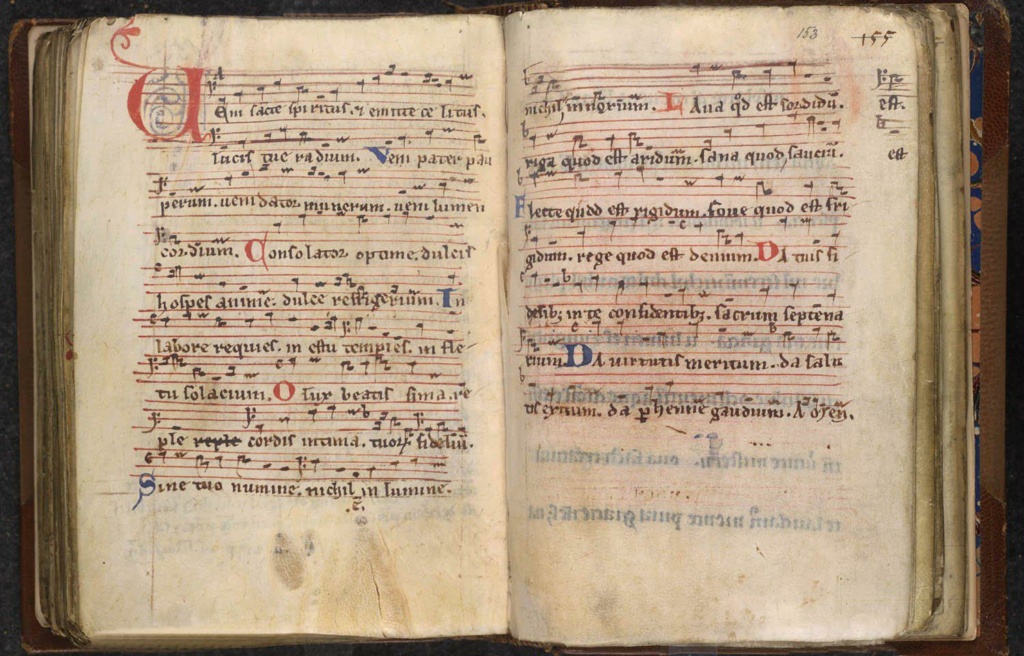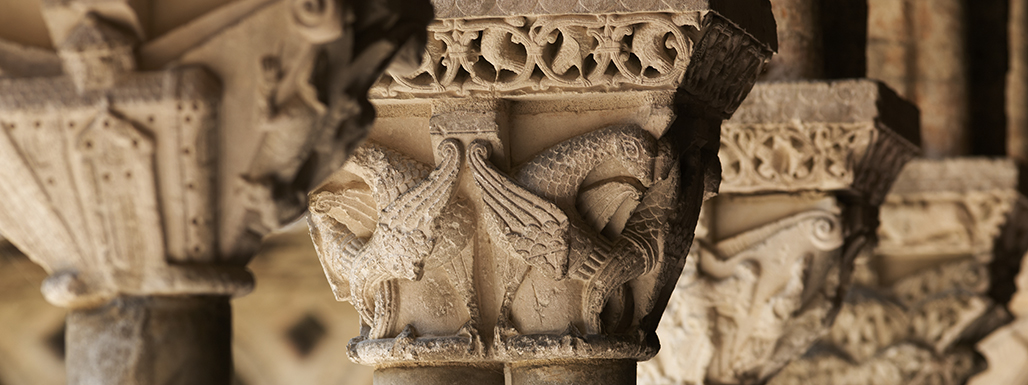Sequence for Pentecost
Veni Sancte Spiritus. H. Schütz, SWV 475. Polychoral version of Heinrich Schütz. Every verse gets its own musicians, using 4 groups (choirs) each consisting of 1 or 2 vocalists and instruments, the ensemble sustained by 2 theorbes, and organ (basso continuo). Wonderful dialogues, breathtaking modulations (esp. around ‘o lux beatissima’), very rich texture. Climax is the invocation and celebration of the Holy Spirit as ‘Lux beatissima’. All choirs join forces [CD 27: Heinrich Schütz Gesamteinspielung – Psalmen & Friedensmusiken. – track 3 ]
Background, origin, author.
This Sequence follows the Alleluia verse at Pentecost: ‘Veni Sancte Spiritus, reple tuorum corda fidelium etc’, expanding the thought expounded therein. Already in 1915, in the series Thesaurus Hymnologicus, vol 54.1, C. Blume has drawn the list of quasi all manuscripts containing this sequence (earliest appearance early 12th century), including variant readings. Surprisingly few ! Only one verse is complex: “Sine tuo numine nihil est in homine, nihil est innoxium.” (litterally: “Without your ‘divine genius’ there is nothing in man, there is no innocence.” In many modern editions/versions, one syllable is different: ‘”Sine tuo nomine, nihil est in homine, nihil est innoxium.” Sometimes one also finds ‘lumine‘ iso ‘homine‘. All these variant readings are improvements, corrections (e.g. of imperfect rhyme), so probably not original (lectio difficilior principle – see below).
The text is often attributed to Pope Innocent III — or to Stephen Langton (archbishop of Canterbury) by British authors. IMHO: Attributions to famous persons should not be accepted at face value, unless there is also some documentary evidence supporting it. In this case, there is only a nice ‘story’, an anecdote: While visiting Rome, Abbot Ulrich of St. Gallen is having a conversation with Pope Innocent. They discuss Notker Balbulus’ sequence for Pentecost (the predecessor of our Sequence):‘Sancti spiritus adsit nobis gratia’. The pope confesses he has composed one himself, and asked for it by Ulrich, he produces the text of the Veni sancte Spiritus. The rest is history… As befits a good story: It could have happened. Abbot Ulrich and Innocentius knew each other. In 1215 Ulrich was in Rome for the 4th Lateran Council. a little later this sequence begins its triumphal rise, supplanting Notker’s Sequence (that is a fact). So, it sounds quite plausible (I would say: Alert!). The almost omniscient hymnologist Blume accepts the story, but what he doesn’t realize (takes into account) is that a good legend also does its best to seem plausible. So let’s be careful. Biographers of Saints, Abbots and Popes are hagiographers (as well). But: most important counter-argument is a fact: Some of the oldest surviving versions we find in manuscripts dating back to the 12th century (!), i.e. well before the meeting between Innocentius and Ulrich. My tip: We should rather read this kind of attributions as indications of the great value attributed to the text by the users: These words are worthy of a saint, so (they must have been) written by a saint. Cf. Psalms of David, hymns of Ambrosius, Bernardus etc.
Text (Latin – English)
The English translation is by J.M. Neale (1818-1866), an English Anglican priest, scholar and hymn-writer (translator). I swapped two lines (for concordance with the Latin text), and replaced ‘Strengthen what goes erringly’ with ‘Straighten what goes erringly’ (Latin: rege quod est devium) – was this perhaps a transcription/printing error? Strenghten is simply erroneous (meaning: contre-sense).
| Veni, Sancte Spiritus, et emitte caelitus lucis tuae radium. Veni, pater pauperum, veni, dator munerum, veni, lumen cordium. | Come, Thou holy Paraclete, And from Thy celestial seat Send Thy light and brilliancy: Father of the poor, draw near; Giver of all gifts, be here; Come, the soul’s true radiancy. |
| Consolator optime, dulcis hospes animae, dulce refrigerium. In labore requies, in aestu temperies, in fletu solatium. | Come, of comforters the best, Of the soul the sweetest guest, Come in toil refreshingly: Thou in labor rest most sweet, Thou art shadow from the heat, Comfort in adversity. |
| O lux beatissima, reple cordis intima tuorum fidelium. Sine tuo numine,2 nihil est in homine,3 nihil est innoxium. | O Thou Light, most pure and blest, Shine within the inmost breast Of Thy faithful company. Where Thou art not, man hath naught; Every holy deed and thought Comes from Thy divinity. |
| Lava quod est sordidum, riga quod est aridum, sana quod est saucium. Flecte quod est rigidum, fove quod est frigidum,4 rege quod est devium. | What is soilèd, make Thou pure; What is wounded, work its cure; What is parchèd, fructify; What is rigid, gently bend; What is frozen, warmly tend; Strengthen – Straighten?5 – what goes erringly. |
| Da tuis fidelibus, in te confidentibus, sacrum septenarium. Da virtutis meritum, da salutis exitum, da perenne gaudium. | Fill Thy faithful, who confide In Thy power to guard and guide, With Thy sevenfold mystery. Here Thy grace and virtue send: Grant salvation to the end, And in Heav’n felicity. |

Sequence : rythmical prose
A sequence – originally – is a prayer in rythmical prose . Latin: ‘Prose’ = text following an liturgical verse (e.g. alleluia-verse, lectio, or prayer). In the service for Pentecost the Alleluia verse is: ‘Veni Sancte Spiritus, reple tuorum corda fidelium etc.’. The sequence (as the name says) continues the thought. In this case there is also influence from the ancient hymn ‘Veni Creator Spiritus’ . This sequence itself is mesmerising, because of the repetitions, the sounds: Veni (come), Da (give). Persistent endrhyme (-ium). And then – of course – the exstatic invocation, praise of the Spirit as godly light: O Lux beatissima. The contrast between that shining light and the shallowness of man is huge, leading to 6 iso-rithmic prayers. Just read those lines aloud. The scansion will get it under your skin.

The antiphone
The sequence is – a said above – inspirered by (a continuation of) the antiphone with the same beginning. Here performed as a little ‘spiritual concert’ by Weser-Renaissance (composer: Heinrich Schütz, SWV 328). By the way: the prayer of the old-church (catholic) is fully present in the oeuvre of this lutheran composer.
Pentecost 2023, Dick Wursten
- Die Sequenzen des Thesaurus Hymnologicus H.A. Daniels und andere Sequenzenausgaben. Des zweiten Teiles, eds. Cl. Blume en H.M. Bannister, Leipzig: 1915. The sequence is nr. 153, pp. 234-238.
- Some mss. nomine
- Some mss. lumine. Imperfect rhyme, so lectio difficilior.
- Some mss. est languidum. This is a lectio difficilior, so perhaps authentical?
- Strengthen is simply wrong. Did Neale in his original ms. write ‘Straighten’ and did the typesetter misread it for…?
